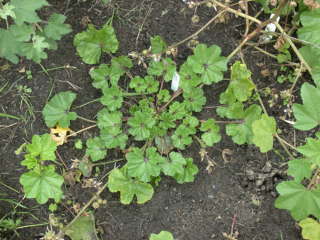back to The Malva Pages
Malva sylvestris L.![]() Tall Mallow
Tall Mallow![]() Common Mallow
Common Mallow![]() High Mallow
High Mallow![]() Petite Mauve
Petite Mauve![]() p'tite mauve
p'tite mauve Malva común, Malva silvestre
Malva, Vauma
![]() Malva silvestre
Malva silvestre Malva
méiba
riondella
nalba
![]() mamarutza, marmaredda, marva, Narbedda
mamarutza, marmaredda, marva, Narbedda Nalba de culturä, nalba de padure
Kultur-käsepappel
Groot Kaasjeskruis
rödmalva
Apotekerkattost
Kiiltomalva
mets-kassinaeris
Dźiwi šlěz
ślaz dziki
![]() sléz lesní
sléz lesní slez lesný
Gozdni slezenovec
Sljez crni, Sljez divlji, šumski sljez
crni slez
Miškinė dedešva
meža malva
Erdei mályva, mályva, Papsayt
![]() Hocysen Gyffredin
Hocysen Gyffredin![]() Malvo granda
Malvo granda![]() ziga, zigiña
ziga, zigiña Hobbejza tar-raba
![]() Dang-a-uk
Dang-a-uk
Malva sylvestris is an annual (in Eygpt and the Levant), biennial (in much of the Mediterranean region) or perennial herb widely distributed in the Palaeoarctic, from Western Europe to the Himalayas and Central Asia, perhaps to China, and naturalised in many temperate regions.
It is a variable species, varying in flower size and colour, life cycle, habit, and hairiness. Several forms have been described as species or varieties, but the variation of characters is uncorrelated, and most botanists no longer recognise infraspecific taxa, with the possible exception of the Moroccan endemic ssp. subacaulis. A number of the more widely recognised variants are treated below as horticultural groups - Mauritiana, Eriocarpa and Canescens groups.
It is said to reach between 1 or 1.5 m in height in different parts of its range, but I have seen a plant which reaches 3 m in an apparently wild (escape from cultivation?) setting, and several cultivated plants of 2 m or more in height. The plant can be single-stemmed or multi-stemmed. The stems are slender or stout, usually hairy, sometimes glabrous, little branched, or extensively branched at the base or the top or both. The leaves are cordate and orbicular. Basal leaves are scarcely 5-7 lobed; floral leaves are lobed shallowly or divided into triangular lobes up to halfway to the base. The inflorescence is a leafy raceme, the flowers being borne in fasciulate clusters, or less commonly singly or in pairs, in the leaf exils. The emarginate petals are rose to purple with typically 5 (the outer pairs joined at the base), sometimes 3 or 7, darker veins, the veins often being forked towards their apices. The fruit is a schizocarp composed of c. 10 single seeded mericarps. The mericarps have distinct dorsal and lateral faces, and often cohere together, being dispersed as a unit. They may be glabrous or hairy.
Cytology: Malva sylvestris has 42 chromosomes in its diploid complement.
Cultivars
Synonyms:
Synonyms of Malva sylvestris include Althaea godroni Alef., Althaea vulgaris Alef., Malva ambigua Guss., Malva aragonensis Sennen, Malva cathayensis M.G.Gilbert, Y.Tang & Dorr, Malva elata Pemel, Malva elata Salisb., Malva equina Wallr., Malva erecta C.Presl, Malva glabra Desr., Malva grossheimii Iljin, Malva gymnocarpa Pomel, Malva hirsuta C.Presl, Malva longelobata Sennen, Malva longepedunculata Sennen, Malva mauritiana var. sinensis Candolle, Malva mauritiana L., Malva obtusa Moench., Malva orientalis Mill., Malva plebeia Stev., Malva polymorpha Guss., Malva racemosa C.Presl, Malva recta Opiz, Malva ruderalis Salisb., Malva simpliuscula Steud., Malva sinensis Cav., Malva sylvestris ssp. mauritiana (L.) Boiss., Malva sylvestris var. albiflora Candargy, Malva sylvestris var. eriocarpa Boiss., Malva sylvestris var. oxyloba Post, Malva tetuanensis Pau, Malva tomentella C.Presl, Malva vivianiana Rouy, Malva vulgaris S.F.Gray and Malva vulgaris Ten..
Malva sylvestris L. ssp. subacaulis Maire
Subspecies subacaulis is a short-stemmed form from Morocco found at high altitudes (5000-10000 ft) in the Atlas mountains (Djebel Tachdirt, Djebel Ghat, Djebel Siroua). This habit need not be unique; I grew a form (Hinsley 8, pictured) with a presumptively similar habit collected at low altitude in Britain, though in this case the habit did not come true from seed. It is not clear to me that subacaulis is distinct, rather than representing the end of an altitudinal cline. |
 |
Malva sylvestris L. Mauritiana group mauretansk rödmalva
mauri kassinaeris
ślaz maurytański
Mavretanski slezenovec
Tamsiažiedė dedešva
Mauritānijas malva
mórmályva
Malva mauritiana was recognised as a species by Linnaeus, and reduced to a variety by Boissier. Most recent works do not recognise it as a distinct taxon.
Its range is Iberia, Italy and Algeria. Many garden plants are referred to Malva sylvestris var. mauritiana.
Cultivars
Malva sylvestris L. Eriocarpa group![]() jin kui
jin kui
This name covers those plants with tomentose mericarps. These have uniformly hairy stems. They are found from Italy eastwards to the Himalayas, Central Asia and China.
Malva sylvestris L. Canescens group
A form of Malva sylvestris with all parts other than the corolla (and presumably the androecium and gynoecium) covered by a dense whitish wool occurs in the Montpellier region of France, and on the Balearic Isles. This is recognised as var. canescens in some 19th century botanical works.
Malva sylvestris L. Sterile Blue group
Sterile "blue" flowered forms of Malva sylvestris occur as at least two vegetatively propagated cultivars - 'Marina' and 'Primley Blue' - and are also thrown up by the 'Mystic Merlin' and 'Magic Hollyhock' seed strains. Their sterility leads to a widespread belief that they are of hybrid origin - Malva parviflora has been suggested as the other parent. The fact that they are thrown up by seed strains leads me to some skepticism about this, but leaves me lacking an explanation for their consistent sterility.
These plants all have pale violet-blue flowers. I have also observed that a blue-flowered mallow ex 'Mystic Merlin' showed the same 3-lobed form of late season leaves as 'Marina'.
Cultivars
Other blue-flowered mallows are available - 'Bardsey Blue', BLUE FOUNTAIN® 'Depa', 'Cottenham Blue', 'Perry's Blue' and Wallace Blues group. I do not know whether these are also sterile.
Feedback
If you have found any errors on this page, or have any further information about the genus Malva then please contact me at botany@malvaceae.info.
back to The Malva Pages
© 2004, 2005, 2007 Stewart Robert Hinsley